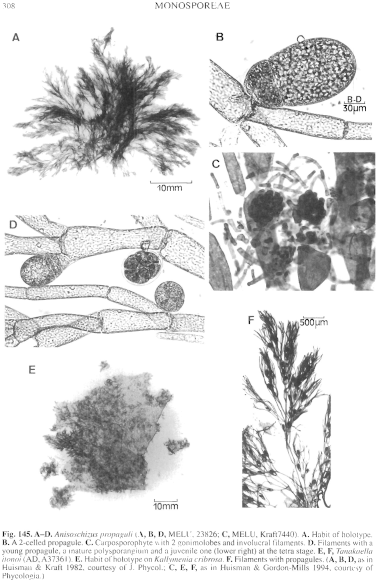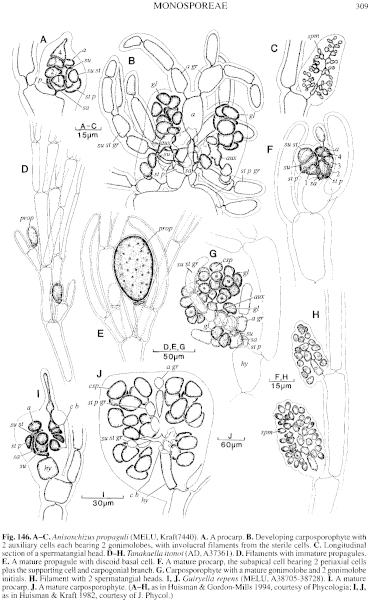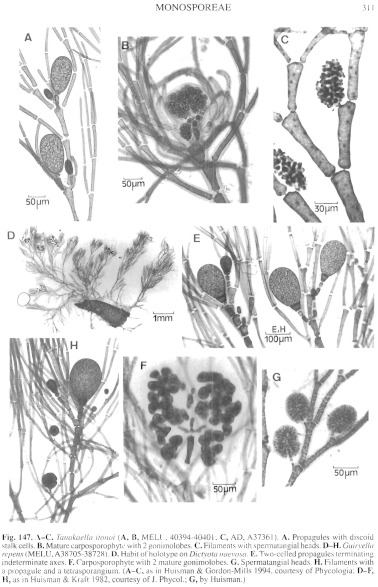|
|
|
|
|
|||||||||||
|
Electronic Flora of South Australia Species Fact Sheet
Phylum Rhodophyta – Order Ceramiales – Family Ceramiaceae – Tribe Monosporeae
Selected citations: Huisman 1997: 199. Silva et al. 1996: 430.
Thallus (Fig. 145E, F) red-brown, 1–5 mm high, forming small erect tufts, subdichotomously branched, from prostrate basal filaments. Attachment by branched haptera; epiphytic on Kallymenia cribrosa and Thamnophyllis lacerata. Structure. Apical cells 8–15 µm in diameter and L/D 6–15, dividing transversely, median and basal cells (20–) 40–100 µm in diameter and L/D 4–10. Cells multinucleate; rhodoplasts discoid.
Reproduction: Propagules (Figs 145F, 146D, E, 147A) borne laterally on upper cells, single celled, ovoid, 55–90 µm in diameter, with a single small discoid basal cell.
Gametophytes dioecious. Procarps (Fig. 146F) borne on the subapical cell of short axes, with 3 periaxial cells, one acting as the supporting cell and bearing a carpogonial branch and a sterile cell; hypogenous cell larger, with a lateral vegetative branch. Post-fertilization only the supporting cell cuts off an auxiliary cell, which produces 3 successive gonimolobes (Figs 146G, 147B) 80–220 µm across, with isodiametric carposporangia 20–25 pin across. The apical cell, supporting sterile cell, and one of the sterile periaxial cells divide and form 3 inner involucral groups around the carposporophyte, and loose outer involucral filaments develop from cells below the fertile axis. Spermatangial heads (Figs 146H, 147C) are borne on upper adaxial ends of median thallus cells, ovoid, 30–45 µm in diameter.
Tetrasporangia borne on upper ends of axial cells, subspherical to slightly ovoid, 20–30 µm in diameter, tetrahedrally divided.
Type from Elliston, S. Aust., on Kallymenia cribrosa, 7 m deep in bay (Shepherd, 21.x.1970); holotype in AD, A37361, isotypes distributed in "Marine Algae of southern Australia" No. 397.
Selected specimens: "Mostyns Lump", Houtman Abrolhos, W. Aust., on Kallymenia cribrosa, 20–24 m deep (Huisman & Kraft, 14.x.1990; MELU, 40394–40401). Charlotte Point, Rottnest I., W. Aust., on K. cribrosa, 18 m deep (Huisman, 20.xii.1992; Murdoch, JH 200). Busselton, W. Aust., on sponge on jetty piles, 6m deep (Huisman, 23.x.1997; MURU, JH 2030-S). Egg I., Isles of St Francis, S. Aust., on K. cribrosa, 32–38 m deep (Shepherd, 11.i.1971; AD, A57179). Elliston, S. Aust., on Thamnophyllis lacerata, 6 m deep near bay entrance (Shepherd, 24.x.1969; AD, A34791). Snapper Point, Port Lincoln, S. Aust., on K. cribrosa, 6–7 m deep (Baldock, 1.i.1964; AD, A27080). West Bay, Wedge I., S. Aust., on K. cribrosa, 20 m deep (O'Leary, 18.i.1992; AD, A61619). Troubridge I., S. Aust., on K. cribrosa, 23 m deep (Shepherd, 4.ii.1969; AD, A57181).
Distribution: Houtman Abrolhos and Rottnest I., W. Aust.; Egg I., Isles of St Francis to Troubridge I., S. Aust.
References:
HUISMAN, J.M. & GORDON-MILLS, E.M. (1994). A proposal to resurrect the tribe Monosporeae Schmitz et Hauptfleisch, with a description of Tanakaella itonoi sp. nov. (Ceramiaceae, Rhodophyta) from southern and western Australia. Phycologia 33, 81–90.
HUISMAN, J.M. (1997). Marine Benthic Algae of the Houtman Abrolhos Islands, Western Australia. In Wells, F.E. (Ed.) The Marine Flora and Fauna of the Houtman Abrolhos Islands, Western Australia, pp. 177–237. (W. Aust. Museum: Perth.)
SILVA, P.C., BASSON, P.W. & MOE, R.L. (1996). Catalogue of the Benthic Marine Algae of the Indian Ocean. (University of California Press: Berkeley, Los Angeles & London.)
The Marine Benthic Flora of Southern Australia Part IIIC complete list of references.
Publication:
Womersley, H.B.S. (24 December, 1998)
The Marine Benthic Flora of Southern Australia
Rhodophyta. Part IIIC. Ceramiales – Ceramiaceae, Dasyaceae
©State Herbarium of South Australia, Government of South Australia
Illustrations in Womersley Part IIIA, 1998: FIGS 145E, F, 146D, H, 147 A–C.

Figure 145 enlarge
Fig. 145. A–D. Anisoschizus propaguli (A, B, D, MELU, 23826; C, MELU, Kraft7440). A. Habit of holotype. B. A 2-celled propagule. C. Carposporophyte with 2 gonimolobes and involucral filaments. D. Filaments with a young propagule, a mature polysporangium and a juvenile one (lower right) at the tetra stage. E, F, Tanakaella itonoi (AD, A37361). E. Habit of holotype on Kallymenia cribrosa. F. Filaments with propagules. (A, B, D, as in Huisman & Kraft 1982, courtesy of J. Phycol.; C, E, F, as in Huisman & Gordon-Mills 1994, courtesy of Phycologia.)

Figure 146 enlarge
Fig. 146.A–C. Anisoschizus propaguli (MELU, Kraft7440). A. A procarp. B. Developing carposporophyte with 2 auxiliary cells each bearing 2 gonimolobes, with involucral filaments from the sterile cells. C. Longitudinal section of a spermatangial head. D–H. Tanakaella itonoi (AD, A37361). D. Filaments with immature propagules. E. A mature propagule with discoid basal cell. F. A mature procarp, the subapical cell bearing 2 periaxial cells plus the supporting cell and carpogonial branch. G. Carposporophyte with a mature gonimolobe and 2 gonimolobe initials. H. Filament with 2 spermatangial heads. I, J. Guiryella repens (MELU, A38705-38728). I. A mature procarp. J. A mature carposporophyte. (A–H, as in Huisman & Gordon-Mills 1994, courtesy of Phycologia; I,J, as in Huisman & Kraft 1982, courtesy of J. Phycol.)

Figure 147 enlarge
Fig. 147. A–C. Tanakaella itonoi (A, B, MELU, 40394-40401; C, AD, A37361). A. Propagules with discoid stalk cells. B. Mature carposporophyte with 2 gonimolobes. C. Filaments with spermatangial heads. D–H. Guiryella repens (MELU, A38705-38728). D. Habit of holotype on Dictyota naevosa. E. Two-celled propagules terminating indeterminate axes. F. Carposporophyte with 2 mature gonimolobes. G. Spermatangial heads. H. Filaments with a propagule and a tetrasporangium. (A–C, as in Huisman & Gordon-Mills 1994, courtesy of Phycologia; D–F, H, as in Huisman & Kraft 1982, courtesy of J. Phycol.; G, by Huisman.)

|
Email Contact: State Herbarium of South Australia |

|